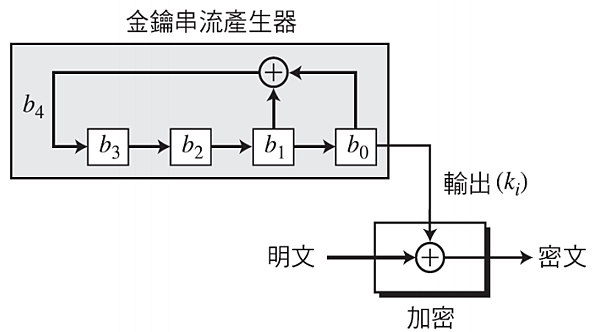close
簡易版LFSR程式撰寫
線性反饋移位暫存器(Linear feedback shift register,LFSR)是指給定前一狀態的輸出,將該輸出的線性函數再用作輸入的移位暫存器。
範例:
建立一個具備四個記憶單元的線性回饋位移暫存器,其中b4 = b1 ⊕ b0。假設種子是(0001)二進制,在 20 次位移之後的輸出值如下圖表格所表示。

以上述流程簡單解釋先 b4 = b1 ⊕ b0 ,再往右移一個位元,讓 b0 成為 key 之後一直重複上述步驟即可。

//簡易LFSR程式碼部分(建議以cpp檔儲存)
/*LFSR*/
#include <stdio.h>
#include <stdlib.h>
#include <ctype.h>
#include <iostream>
using namespace std;
int main(void) {
char *p; //明文
char *c=new char(40); //密文
int b[10]; //種子
int x[9]; //暫存器
FILE *fPtr;
unsigned long leng, count;
//xor
for(int i=0;i<9;i++){
x[i]=0;
}
//暫存器選擇
cout<<"請選擇暫存器(1~8)(如要結束請按88)"<<endl;
int i=0;
cin>>x[i];
i++;
while(x[i-1]!=88){
cin>>x[i];
i++;
}
//seed(八位數)
cout<<"input seed: ";
for(int k=8;k>0;k--){
cin>>b[k];
}
i=0;
b[9]=0;
while(x[i]!=88){
b[9]=b[9]^b[x[i]];
i++;
}
//讀入檔案(須先建立source.txt)
fPtr = fopen("source.txt", "r");
fseek(fPtr, 0, SEEK_END);
leng = ftell(fPtr);
fseek(fPtr, 0, SEEK_SET);
p = (char *) malloc((leng + 1) * sizeof(char));
fread(p, 1, leng, fPtr);
fclose(fPtr);
p[leng] = '\0';
count = 0;
for (int i=0; i<leng; i++)
p[count++] = p[i];
p[count] = '\0';
printf("\n明文: %s\n\n", p);
// 將字串編碼
for(int m=0;m<leng;m++){
for(int j=0;j<9;j++){
b[j]=b[j+1];
}
c[m]=b[0]^p[m];
i=0;
b[9]=0;
while(x[i]!=88){
b[9]=b[9]^b[x[i]];
i++;
}
}
cout<<"LFSR 密文: ";
for(int b=0;b<leng;b++){
cout<<c[b];
}
//輸出檔案
fPtr = fopen("result.txt", "w");
fwrite(c, 1, count, fPtr);
fclose(fPtr);
return 0;
}
程式執行結果:

文章標籤
全站熱搜


 留言列表
留言列表